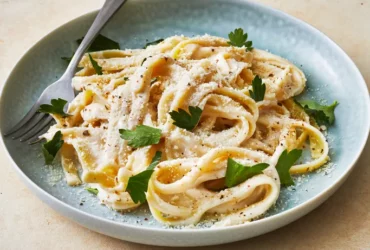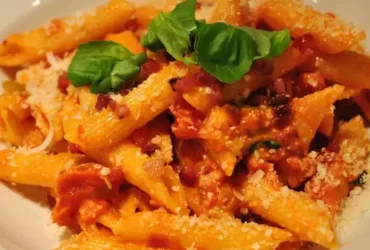Ingredients
Meatballs
When it comes to making authentic Italian spaghetti sauce with meatballs, selecting the right ingredients is crucial for achieving that distinctive flavor and texture.
The core components of the dish are, of course, the meatballs themselves. Traditionally, Italian meatballs (Polpette) are made from ground meat, typically a combination of beef, pork, and sometimes veal or other meats.
The proportions of each type of meat can be adjusted according to personal preference and regional traditions. Some recipes may use more beef for heartiness, while others may opt for leaner pork or a mix of the two.
It’s also essential to choose the right cuts of meat. For ground beef, chuck or round works well. Ground pork should come from a tender cut like loin or belly.
A good Italian meatball typically includes additional ingredients beyond just meat, such as breadcrumbs (Pangrattato), grated Parmesan cheese (Parmigiano Reggiano), finely chopped onion and/or carrot for added moisture and flavor, fresh parsley or basil for freshness, eggs to bind the mixture together, salt, black pepper, and sometimes a pinch of red pepper flakes for a touch of spice.
Other ingredients that play a crucial role in traditional Italian spaghetti sauce with meatballs include olive oil (preferably extra virgin) as a cooking medium and flavor enhancer, onions (both raw and caramelized), garlic (raw or roasted), canned crushed tomatoes or fresh tomatoes when available, tomato paste for concentrated flavor, dried basil and oregano, bay leaves for added depth of flavor, salt and black pepper to season, sugar to balance acidity if necessary, red wine (optional) or beef broth for added richness.
While some variations may use different ingredients or substitutes, sticking as closely as possible to these traditional components will help you create a rich, authentic-tasting Italian spaghetti sauce with meatballs that’s sure to please even the most discerning palates.
1 pound ground beef
The first ingredient to focus on for this Italian Spaghetti Sauce with Meatballs Recipe is 1 pound ground beef. Ground beef is a fundamental component of meatballs, providing texture and flavor that complements the pasta and sauce perfectly.
For most traditional Italian recipes, it’s essential to choose high-quality ground beef. You can opt for either regular or lean ground beef; however, if you’re looking for a more authentic taste, go with regular ground beef (around 80/20 ratio of meat to fat). This will give your meatballs a richer flavor and a tender texture.
Some common options for ground beef include:
Angus
Known for its marbled quality, which contributes to its rich flavor and tender texture. It’s an excellent choice if you want a classic, robust taste in your meatballs.
Chuck
A popular cut of beef, chuck is often used as ground beef due to its mild flavor and coarse texture, making it suitable for slow-cooked dishes like meatballs.
Sirloin or Round
These leaner cuts of beef can work well if you want a slightly healthier option. However, they might make the meatballs less flavorful.
Before cooking the ground beef, make sure to handle it safely and hygienically. Ensure your hands are clean, and any utensils used for handling the meat are sanitized. This will prevent any potential contamination and foodborne illnesses.
It’s also worth noting that some recipes might use alternative options like ground turkey or pork as a substitute for ground beef. However, this article focuses on the traditional Italian Spaghetti Sauce with Meatballs Recipe, which typically employs ground beef.
1/2 cup breadcrumbs
Breadcrumbs play a crucial role in enhancing the texture and flavor of our Italian Spaghetti Sauce with Meatballs recipe. The 1/2 cup measurement represents a significant portion of breadcrumbs, which will be used to coat meatballs, providing a delightful crunch and helping them hold their shape during cooking.
For this specific ingredient, we recommend using plain or whole wheat breadcrumbs. Panko-style breadcrumbs are also an excellent option as they yield a lighter, airier texture that will add a pleasant contrast to the dish. Avoid using seasoned breadcrumbs, as they might alter the overall flavor profile of our sauce and meatballs.
The key characteristic of breadcrumbs in this recipe is their ability to absorb moisture without becoming soggy or disintegrating during cooking. This property is especially important for meatballs, which need a crispy exterior to prevent them from falling apart in the sauce. By using high-quality breadcrumbs, we can create a delicate balance between texture and flavor that will elevate our Spaghetti Sauce with Meatballs recipe.
1 egg
An egg is an essential ingredient that serves multiple purposes in this Italian spaghetti sauce with meatballs recipe.
Firstly, eggs help to enrich and thicken the sauce. When cooked for a few minutes, the egg yolks will break down and emulsify with the oil and tomato puree, creating a velvety texture that coats the pasta perfectly. This is especially important when cooking spaghetti, as it helps to prevent the sauce from becoming too watery.
Additionally, eggs also serve as a binder for the meatballs. When mixed with ground meat and breadcrumbs, the egg yolk will hold everything together, ensuring that the meatballs remain intact and don’t fall apart during cooking.
The egg white can be beaten separately and added to the sauce as a stabilizer. This helps to prevent the sauce from breaking or separating when it’s heated for a long period of time. By adding the beaten egg whites gradually, you’ll achieve a smooth and even consistency that will cling beautifully to the pasta.
It’s essential to note that using an egg in the sauce is not just about providing richness and thickness; it also enhances the overall flavor profile. Eggs have a subtle nutty and creamy taste that complements the flavors of the tomato, garlic, and herbs in this spaghetti sauce recipe.
1/4 cup grated Parmesan cheese
When it comes to the ingredients for an authentic Italian spaghetti sauce with meatballs, one crucial component stands out: grated Parmesan cheese. Specifically, we’ll need 1/4 cup of this versatile and flavorful cheese to enhance the overall taste and richness of our dish.
Parmesan cheese, also known as Parmigiano-Reggiano, is a classic Italian cheese originating from the Parma and Reggio regions in Italy. Its distinctive granular texture and nutty flavor make it an ideal addition to various Italian recipes, including pasta sauces, salads, and risottos.
The key characteristics of high-quality Parmesan cheese are its age, region, and production methods. Authentic Parmigiano-Reggiano must be produced within specific geographic areas in Italy and adhere to traditional aging processes, which can take anywhere from 12 to 36 months or more.
The process of making Parmesan cheese involves heating cow’s milk, then adding rennet (an enzyme) to separate the curds from the whey. The resulting curd is then shaped into large blocks and aged for extended periods to develop its characteristic flavor and texture.
When used in our spaghetti sauce with meatballs recipe, the 1/4 cup of grated Parmesan cheese adds a savory, slightly sweet taste and helps balance out the acidity from the tomatoes. It’s essential to grate the Parmesan cheese just before adding it to the dish to ensure maximum flavor release.
In summary, using high-quality, aged Parmigiano-Reggiano is crucial for an authentic Italian spaghetti sauce with meatballs. The 1/4 cup of grated cheese contributes a rich, nutty flavor and helps round out the overall taste experience of this classic recipe.
Salt and pepper, to taste
The ingredient salt and pepper, to taste, plays a crucial role in bringing out the flavors of the Italian Spaghetti Sauce with Meatballs. While it’s often an afterthought, using high-quality salt and pepper can elevate the entire dish.
Salt is essential in balancing the sweetness of the tomatoes and the savory flavor of the meatballs. It enhances the overall umami taste, making each bite more satisfying. When selecting a salt for this recipe, consider using kosher salt or sea salt for their coarse texture and mild flavor.
Pepper, on the other hand, adds a subtle kick that complements the spices in the meatballs. You can use either black or white pepper, depending on your personal preference. If you’re looking for an extra boost of heat, consider adding some red pepper flakes to the mix.
The key to using salt and pepper effectively is to taste as you go. Start with a small amount of each and adjust to suit your taste preferences. Remember that it’s always easier to add more seasoning than it is to remove excess salt or pepper from the dish.
Here are some guidelines for using salt and pepper in the Italian Spaghetti Sauce with Meatballs Recipe:
- Salt:Use about 1-2 teaspoons of salt per pound of ground meat. You can also use salt to taste as you cook the sauce.
- Pepper:Add a few grinds of pepper to taste, or use about 1/4 teaspoon of black or white pepper per serving.
Ultimately, the amount of salt and pepper you use is up to your personal preference. Experiment with different amounts to find the perfect balance of flavors for your Italian Spaghetti Sauce with Meatballs recipe.
Sauce
Basic Sauce
The sauce is one of the fundamental components of an authentic Italian Spaghetti dish, and it plays a pivotal role in bringing together the flavors, textures, and aromas that make this classic recipe so beloved. In its most basic form, a traditional Italian tomato-based sauce, also known as “salsa” or “ragù,” typically consists of a combination of ingredients such as onions, garlic, carrots, celery (known collectively as “soffritto”), tomatoes, olive oil, salt, and sometimes red pepper flakes for added depth.
When it comes to creating the foundation of this sauce, the key is in achieving a harmonious balance between the sweetness of the onions and carrots, the pungency of the garlic, and the acidity of the tomatoes. This blend creates a rich and savory flavor profile that is both comforting and familiar. It’s also worth noting that using high-quality ingredients will make all the difference in the final taste.
While store-bought tomato sauces are convenient, making your own allows you to tailor the flavor to your liking and ensures the freshest possible ingredients. Fresh tomatoes add a vibrant color and more pronounced tomato taste compared to canned or jarred varieties. However, for certain recipes like our Italian Spaghetti Sauce with Meatballs, using crushed canned tomatoes is more practical due to their texture and concentration of tomato essence.
The cooking process for basic sauce typically involves sautéing the soffritto (the combination of onions, garlic, carrots, and celery) until it reaches a golden-brown color, which intensifies its natural sweetness. This step should be done slowly over low heat to prevent burning or caramelizing too quickly, thereby affecting the overall flavor of the sauce.
Next, crushed tomatoes are added along with olive oil and other seasonings like salt and sometimes red pepper flakes for added depth. The mixture is then simmered over medium heat until it thickens into a smooth, velvety consistency that coats the back of a spoon. This process can take anywhere from 20 to 40 minutes, depending on how long you choose to let the sauce reduce.
Some cooks also like to add red wine for an enhanced flavor profile. The acidity and tannins in the wine help break down the tomatoes’ natural sweetness further, leading to a more complex taste experience. However, if you’re aiming for a traditional Italian tomato sauce recipe, omitting the red wine will still yield a delicious result.
When making meatballs (or in this case, adding pre-cooked meatballs to your sauce), it’s essential to let them simmer long enough so they absorb all the flavors of the sauce. This is why it’s often recommended to cook both components separately before combining them together towards the end of the recipe.
This Italian Spaghetti Sauce with Meatballs Recipe is a staple in many households around the world. The key to making this dish shine lies not only in the ingredients but also in how they are combined and allowed to develop over time. By investing your patience and care into each step of the process, you’ll find that the final product yields an authentic Italian dining experience like no other.
Remember, practice makes perfect when it comes to creating this beloved dish. Experiment with different ingredients, cooking times, and techniques until you achieve a taste that suits your family’s preferences.
2 tablespoons olive oil
The star of the show in this Italian Spaghetti Sauce with Meatballs Recipe is, of course, the sauce itself. A good sauce is the backbone of any great pasta dish, and a well-made sauce can elevate even the humblest of ingredients into something truly special.
In terms of composition, our sauce will be made up of several key components, each of which plays an important role in bringing out the flavors of the other ingredients. The first of these is olive oil, used to sauté the aromatics and add a rich depth of flavor to the sauce.
To begin with, we’ll start by adding 2 tablespoons of olive oil to a large saucepan over medium heat. This will allow us to slowly cook out some of the bitterness in the vegetables as they sauté, creating a smoother and more refined flavor profile for our sauce.
Once the olive oil is hot, we’ll add in some minced onions and sauté them until they’re translucent and starting to caramelize. This will bring out their natural sweetness and add a hint of richness to the sauce.
Next, we’ll add in some minced garlic and cook for another minute or two, allowing its pungency to mingle with the onions and olive oil. This will create a complex and aromatic flavor that will complement the other ingredients perfectly.
4 garlic cloves
The art of creating a rich and flavorful Italian Sauce for your spaghetti dish starts with the foundation ingredients, one of which is garlic. While four cloves may seem like an excessive amount to some, it’s essential to understand that garlic plays a crucial role in developing the depth and aroma of the sauce. Here are some reasons why using 4 cloves of garlic in your Italian Spaghetti Sauce with Meatballs Recipe is beneficial:
Flavor Enhancement: Garlic adds a pungent flavor that complements the sweetness of the tomatoes and enhances the overall taste experience.
Promotes Aroma
The fragrance of garlic mingles with the simmering sauce, creating an irresistible aroma that wafts through your kitchen and tantalizes your guests’ senses.
When using 4 cloves of garlic, be sure to mince them finely so they distribute evenly throughout the sauce. This allows their flavors to meld together and intensify as the sauce cooks, creating a harmonious balance of tastes that will leave everyone asking for more.
To get the most out of your 4 cloves of garlic, it’s essential to cook them gently at first. Sauteing the garlic in olive oil before adding the other ingredients helps to mellow its flavor, allowing it to blend seamlessly with the rest of the sauce without overpowering it.
Remember, using 4 cloves of garlic might seem like an unusual amount, but trust the Italian culinary tradition – a little goes a long way in creating an authentic and delicious Sauce for your Spaghetti dish with Meatballs!
1 can (28 oz) crushed tomatoes
The sauce is a crucial component of this Italian Spaghetti Sauce with Meatballs recipe, and it’s where the magic happens. The foundation of our sauce is crushed tomatoes, which provide a rich, tangy flavor and a velvety texture that coats every strand of spaghetti.
Specifically, we’re using one 28-ounce can of crushed tomatoes as our base ingredient. These are simply peeled and cored tomatoes that have been crushed or pureed to create a smooth consistency.
What to Look for in Crushed Tomatoes
- No added salt or sugars: We’re aiming for a homemade flavor without any processed additives, so make sure your crushed tomatoes don’t contain any extra salt or sugar. These will only dilute the natural flavors we want to emerge.
- Low acidity: Crushed tomatoes with low acidity levels will help balance our sauce’s overall pH and create a more refined taste experience.
Avoid using crushed tomatoes from brands that add unnecessary preservatives or flavor enhancers, as these can impact the authenticity of your Italian Spaghetti Sauce with Meatballs. Stick to reputable labels that prioritize fresh, natural ingredients for optimal results!
1 cup beef broth
The task of working with sauce in an Italian Spaghetti Sauce with Meatballs Recipe involves several key components, including beef broth.
Beef broth is a fundamental ingredient in many Italian sauces, including this spaghetti sauce recipe. It adds depth and richness to the dish, complementing the flavors of the tomato sauce, meatballs, and herbs.
Main Functions of Beef Broth in the Recipe
Moisturizer
The beef broth helps to maintain a saucy consistency and prevents it from becoming too thick or sticky. It ensures that the sauce coats the pasta evenly and doesn’t dry out during cooking.
Flavor Enhancer
Beef broth adds a subtle, meaty flavor to the sauce without overpowering the other ingredients. This enhances the overall taste experience of the dish and makes it more satisfying.
Texture Modifier
The beef broth can also help to thin out the sauce if it becomes too thick during cooking, making it easier to pour over the pasta.
Tips for Using Beef Broth in This Recipe
Use High-Quality Broth
To get the best flavor out of your beef broth, use a high-quality store-bought or homemade option. Avoid using low-sodium or watered-down broths as they can negatively impact the taste and texture of the sauce.
Reduce Broth Before Adding
To avoid diluting the flavor of your sauce, reduce the beef broth slightly before adding it to the tomato sauce. This will help to concentrate the flavors and create a more intense sauce.
Don’t Overuse Broth
Too much beef broth can make the sauce too watery or overpowering. Use it sparingly and adjust to taste, ensuring that the flavor of the tomato sauce remains dominant.
1 tablespoon tomato paste
In this Italian Spaghetti Sauce with Meatballs recipe, the ingredient “1 tablespoon tomato paste” plays a crucial role in enhancing the flavor and depth of the sauce.
What is Tomato Paste?
Tomato paste is a concentrated form of tomatoes that has been cooked down to remove excess water, resulting in a thick, intense paste with a rich, tangy flavor. It’s commonly used in Mediterranean and Italian cooking to add depth and richness to sauces, stews, and braises.
Why Use Tomato Paste?
Tomato paste is an essential ingredient in many Italian recipes because it:
- Provides intense tomato flavor without the water content of fresh tomatoes
- Adds depth and richness to sauces and stews
- Helps to thicken sauces without adding excess starch or sugar
- Cuts down cooking time by reducing the amount of liquid required
The Importance of Tomato Paste in This Recipe
In this Italian Spaghetti Sauce with Meatballs recipe, the 1 tablespoon of tomato paste is essential for:
- Adding a concentrated tomato flavor to the sauce
- Enhancing the overall depth and richness of the sauce
- Helping to thicken the sauce without adding excess starch or sugar
How to Use Tomato Paste?
To use tomato paste effectively in this recipe, be sure to:
- Mix it with the other ingredients at the beginning of cooking to allow the flavors to meld together
- Cook the sauce over low heat for an extended period to allow the flavors to develop and thicken
- Stir the sauce frequently to prevent scorching or sticking to the bottom of the pan
Conclusion
The use of tomato paste in this Italian Spaghetti Sauce with Meatballs recipe is crucial for achieving a rich, intense flavor and a thick, velvety texture. By understanding the importance and proper usage of tomato paste, you’ll be able to create a truly authentic and delicious Italian dish that’s sure to impress your family and friends.
Salt and pepper, to taste
Sauce is a crucial component of Italian cooking, particularly in this Italian Spaghetti Sauce with Meatballs recipe. In this context, the sauce refers to the tomato-based sauce that coats the spaghetti and meatballs.
The ingredients for the sauce are as follows:
Tomato sauce
A mixture of crushed tomatoes, garlic, and herbs such as basil and oregano. The type of tomato used can be either canned or fresh, with canned tomatoes being a more common choice.
Red wine
A small amount of red wine is added to the sauce for depth of flavor and to enhance the overall taste.
Olive oil
Used to sauté the aromatics and cook the meatballs, olive oil adds a rich and fruity flavor to the dish.
Meatballs
Sausages or homemade meatballs made from ground beef, pork, or a combination of the two. The meat mixture is seasoned with salt, pepper, and herbs before being formed into balls and cooked in the sauce.
The instructions for preparing the sauce are as follows:
- In a large skillet or Dutch oven, heat some olive oil over medium heat.
- Once hot, add chopped onions and sauté until translucent, about 3-4 minutes.
- Add minced garlic and cook for another minute, stirring constantly to prevent burning.
- The salt and pepper, to taste is a crucial step in seasoning the sauce. Salt enhances the flavors of the ingredients, while pepper adds depth and a subtle kick.
Cooking the Meatballs and Sauce
Instructions
Cooking the meatballs is a crucial step in preparing the classic Italian dish known as spaghetti sauce with meatballs. To ensure that the meatballs are cooked to perfection, it’s essential to follow these steps carefully.
Start by preheating your oven to 400°F (200°C). This will allow for even cooking and help prevent the meatballs from drying out.
In a large mixing bowl, combine 1 pound of ground beef with 1/2 cup of breadcrumbs, 1 egg, 1/4 cup of grated Parmesan cheese, 1 tablespoon of olive oil, and a pinch of salt and pepper. Mix all the ingredients together until they are well combined.
Use your hands to shape the mixture into small meatballs, about 1 1/2 inches in diameter. You should end up with around 20-25 meatballs.
Place the meatballs on a baking sheet lined with parchment paper, leaving about 1 inch of space between each meatball to allow for even cooking.
Bake the meatballs in the preheated oven for 18-20 minutes, or until they are cooked through and lightly browned on the outside. You can also cook them in a skillet on the stovetop over medium heat, but keep an eye on them to prevent burning.
While the meatballs are cooking, you can start preparing the sauce. In a large saucepan, sauté 1 onion, 2 cloves of garlic, and 2 cups of chopped fresh tomatoes in 2 tablespoons of olive oil until they are soft and fragrant.
Add 1 can of crushed tomatoes (28 oz), 1 teaspoon of dried oregano, 1 teaspoon of dried basil, salt, and pepper to the saucepan. Stir everything together and bring the sauce to a simmer.
Let the sauce cook for 20-30 minutes, stirring occasionally, until it has thickened and reduced slightly. You can also add other ingredients to the sauce, such as red wine or beef broth, to give it more depth of flavor.
Once the meatballs are done cooking, remove them from the oven and carefully place them into the saucepan with the sauce. Let them simmer in the sauce for a few minutes to absorb all the flavors.
To serve, cook your spaghetti according to the package instructions until it’s al dente. Drain the pasta and add it to the saucepan with the meatballs and sauce. Toss everything together until the pasta is well coated with the sauce. Serve immediately, topped with grated Parmesan cheese and some chopped fresh parsley if desired.
This classic Italian dish is a staple for a reason – its combination of rich flavors and textures is sure to satisfy even the pickiest eaters. Buon appetito!
Preheat oven to 400°F (200°C).
To cook the meatballs and sauce, start by preheating your oven to 400°F (200°C). This will ensure that they cook evenly and at a consistent temperature.
Next, prepare the meat mixture for the meatballs. You’ll need:
- 1 pound of ground beef
- 1/2 cup of breadcrumbs
- 1 egg
- 1/4 cup of grated Parmesan cheese
- 1 tablespoon of olive oil
- 2 cloves of garlic, minced
- 1 teaspoon of dried oregano
- Salt and pepper to taste
Mix all the ingredients together in a bowl until they’re well combined. Be careful not to overmix.
Use your hands to shape the mixture into meatballs, about 1 1/2 inches (3.8 cm) in diameter. You should end up with around 20-25 meatballs.
Place the meatballs on a baking sheet lined with parchment paper, leaving some space between each one to allow for even cooking.
Bake the meatballs in the preheated oven for 15-20 minutes, or until they’re cooked through and lightly browned on the outside. You can check for doneness by cutting into one of the meatballs – if it’s still pink inside, give them a few more minutes.
While the meatballs are cooking, prepare the sauce. In a large saucepan, heat:
- 1/4 cup of olive oil
- 2 cloves of garlic, minced
Add 28 oz (794g) of crushed tomatoes, 2 tablespoons of tomato paste, and a pinch of salt and pepper to the saucepan.
Stir everything together and bring the sauce to a simmer over medium-low heat. Let it cook for about 10-15 minutes, stirring occasionally, until the sauce has thickened slightly and reduced slightly in volume.
Once the meatballs are done cooking, remove them from the oven and carefully place them into the saucepan with the tomato sauce. Let them simmer in the sauce for a few minutes to absorb all the flavors.
Serve the meatballs with the homemade spaghetti sauce over cooked spaghetti noodles. Enjoy your delicious Italian Spaghetti Sauce with Meatballs!
In a bowl, combine meatball ingredients. Form into balls.
To cook delicious Meatballs and a rich, tangy Sauce, follow these steps to create an authentic Italian spaghetti dish.
First, preheat your oven to 400°F (200°C). While the oven is warming up, let’s start preparing our Meatball mixture. In a large bowl, combine ground Pork and Beef (or a combination of both) with some finely chopped onions.
Add salt, pepper, minced garlic, grated Parmesan cheese, breadcrumbs, egg, and a pinch of dried oregano to the meat mixture. Mix all the ingredients together until they’re well combined and the Meatball mixture is smooth.
Use your hands to shape the mixture into small balls, about 1-2 inches (2.5-5 cm) in diameter. You should end up with around 20-25 meatballs depending on their size.
Place the Meatballs on a baking sheet lined with parchment paper, leaving some space between each ball to allow for even cooking. Drizzle with a bit of olive oil and gently roll them around to coat evenly.
Bake the meatballs in the preheated oven for 18-20 minutes or until they’re cooked through and lightly browned on the outside. While the meatballs are baking, let’s prepare our Sauce.
In a large saucepan, heat some olive oil over medium heat. Add finely chopped onions and cook until they’re translucent and starting to caramelize. Then add minced garlic and cook for another minute, stirring constantly to prevent burning.
Next, add canned crushed Tomatoes, dried oregano, salt, and pepper to the saucepan. Stir well to combine all the ingredients. Bring the sauce to a simmer and let it cook for 10-15 minutes or until it’s thickened and reduced slightly.
Once the meatballs are done baking, carefully place them in the Sauce pan and let them simmer together for an additional 5-7 minutes to coat the Meatballs with the rich Sauce.
Bake for 15 minutes or until cooked through.
To cook the meatballs to perfection, it’s essential to ensure they’re fully cooked through before adding them to the spaghetti sauce. To achieve this, you can either bake or fry the meatballs. Let’s explore both methods.
Baking is a healthier option that yields equally delicious results. To bake the meatballs, preheat your oven to 400°F (200°C). Line a baking sheet with parchment paper or aluminum foil for easy cleanup. Place the meatballs on the prepared baking sheet in a single layer, leaving some space between each one to allow even cooking.
Now, here comes the part where you need to bake the meatballs for 15 minutes or until cooked through. This step is crucial as it helps cook the meat evenly and prevents overcooking or undercooking. You can check on them after 10 minutes by cutting one of the meatballs in half. If they’re still raw, return them to the oven for a few more minutes.
While the meatballs are baking, you can prepare the spaghetti sauce according to your preference. Once the meatballs have finished cooking, carefully remove them from the oven and let them cool on a wire rack for a few minutes. Then, add them to the simmering spaghetti sauce, and let them heat through.
This method allows the flavors of the meatballs to meld with the sauce, creating an authentic Italian taste experience. You can also choose to fry the meatballs if you prefer a crisper texture on the outside. Regardless of your preference, make sure to cook the meatballs until they reach an internal temperature of 165°F (74°C) for food safety.
As a general guideline, it’s always better to err on the side of caution when cooking meatballs. If you’re unsure whether they’re cooked through, it’s best to check their internal temperature with a thermometer or cook them for a few more minutes.
Now that you’ve successfully baked your meatballs and added them to the spaghetti sauce, it’s time to serve up this hearty Italian feast. Cook some al dente spaghetti according to package instructions, then toss it with the sauce and meatballs. Garnish with grated Parmesan cheese and a sprinkle of parsley for an authentic Italian touch.
Sauté garlic in oil until fragrant. Add crushed tomatoes and beef broth.
To begin cooking the meatballs, it’s essential to prepare them first. This typically involves mixing ground beef with Breadcrumbs, egg, Parmesan Cheese, salt, and herbs such as parsley and basil in a bowl until well combined.
Once the meat mixture is ready, use your hands to shape each portion into small oval shapes. You can also use an ice cream scoop for more uniform meatballs.
Heat about 1-2 tablespoons of Olive Oil in a large skillet over medium heat until it’s almost smoking. Add the formed meatballs to the skillet and cook them for about 3-4 minutes on each side, or until they’re nicely browned on both sides.
Remove the cooked meatballs from the skillet with a slotted spoon and set them aside on a plate. This will prevent them from cooking further in the sauce.
Now it’s time to make the sauce. Return the same large skillet to medium heat. Add a bit more oil if necessary, then sauté 2-3 cloves of Garlic until they’re fragrant and lightly browned. Be careful not to burn them.
Add two cups of crushed Tomatoes (preferably San Marzano for their sweet flavor) to the skillet along with a cup of beef broth. You can also add a pinch of sugar if you prefer your sauce less acidic.
Bring the sauce to a simmer and let it cook for about 15-20 minutes, stirring occasionally, allowing the flavors to meld together and the sauce to thicken slightly. Season with salt as needed, and if desired, add some dried or fresh basil leaves for added flavor.
Add the cooked meatballs back into the skillet with the sauce and let them simmer in it for another 5-10 minutes, coating them evenly with the flavorful sauce.
Reduce heat and simmer for at least 20 minutes.
In this critical step, it’s essential to let the sauce simmer for a sufficient amount of time to allow all the flavors to meld together and the meatballs to fully absorb the rich flavors of the sauce.
Here’s why reducing the heat and allowing the sauce to simmer is so important
This step helps to break down the connective tissues in the meatballs, making them tender and easier to bite into. As the meatballs simmer in the sauce, they will absorb all the flavors and become incredibly juicy.
The sauce will also thicken as it simmers, coating the spaghetti beautifully when served. A good Italian spaghetti sauce should have a thick and velvety texture that coats the pasta perfectly.
To achieve this level of flavor and texture, make sure to reduce the heat to a gentle simmer (around 180-200°F or 82-93°C). This will allow the sauce to cook slowly and evenly without scorching or burning.
Now, here are some tips for making the most of your cooking time
Use a large skillet with a heavy bottom, such as stainless steel or cast iron. This type of pan will distribute heat evenly and prevent hotspots that can scorch the sauce.
Avoid stirring the sauce too much, as this can break down the flavors and make the sauce thin. Instead, let it simmer undisturbed for 10-15 minutes before giving it a gentle stir to redistribute the flavors.
After at least 20 minutes of simmering, your Italian spaghetti sauce with meatballs will be ready to serve over cooked spaghetti noodles. Be sure to season with salt and pepper to taste, and enjoy the rich and savory flavors of this classic Italian dish!
- Best Dun & Bradstreet (DNB) Alternatives for 2025 - April 24, 2025
- Best Seamless.ai Alternatives for 2025 - April 22, 2025
- Best Coldlytics Alternatives for 2025 - April 22, 2025















